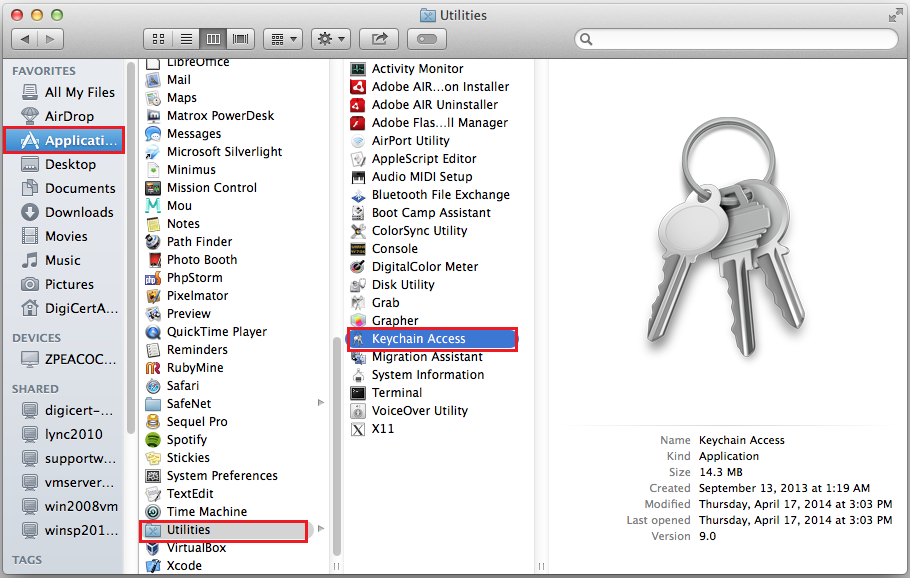

pfx certificate files.įor instructions about transferring Mac 10.9 certificate files, see Mac OS X Mavericks: SSL Certificate Export and Import. It also contains instructions for importing. If there are too many revoked certificates from a CA to list individually, a trust evaluation may instead require that an online certificate status response (OCSP) is needed, and if the response isn’t available, the trust evaluation will fail.This article contains instructions for backing up SSL Certificates in Mac 10.7 to a. This information is consulted whenever a network API function is used to make a secure connection. The list may also include other constraints at Apple’s discretion. The list is aggregated from certificate revocation lists (CRLs), which are published by each of the built-in root certificate authorities trusted by Apple, as well as by their subordinate CA issuers. In iOS 11 or later and macOS 10.13 or later, Apple devices are periodically updated with a current list of revoked and constrained certificates. App Transport Security is automatically applied to apps that are compiled for iOS 9 or later and macOS 10.11 or later.Įvaluating the trusted status of a TLS certificate is performed in accordance with established industry standards, as set out in RFC 5280, and incorporates emerging standards such as RFC 6962 (Certificate Transparency). Invalid certificates always result in a hard failure and no connection. Network connections that don’t meet these requirements will fail unless the app overrides App Transport Security. Servers must support TLS 1.2 and forward secrecy, and certificates must be valid and signed using SHA256 or stronger with a minimum 2048-bit RSA key or 256-bit elliptic curve key. By default, App Transport Security limits cipher selection to include only suites that provide forward secrecy, specifically:ĮCDHE_ECDSA_AES and ECDHE_RSA_AES in Galois/Counter Mode (GCM)Īpps are able to disable the forward secrecy requirement per domain, in which case RSA_AES is added to the set of available ciphers. TLS clients using the SecureTransport APIs can’t use TLS 1.3.Īpp Transport Security provides default connection requirements so that apps adhere to best practices for secure connections when using NSURLConnection, CFURL, or NSURLSession APIs. In iOS 12.2, TLS 1.3 is enabled by default for amework and NSURLSession APIs. In iOS 12.1, certificates issued after October 15, 2018, from a system-trusted root certificate must be logged in a trusted Certificate Transparency log to be allowed for TLS connections. To be more secure, services or apps that require RC4 should be upgraded to use secure cipher suites. By default, TLS clients or servers implemented with SecureTransport APIs don’t have RC4 cipher suites enabled and are unable to connect when RC4 is the only cipher suite available. The RC4 symmetric cipher suite is deprecated in iOS 10 and macOS 10.12. Certificates with RSA keys shorter than 2048 bits are also disallowed. In iOS 11 or later and macOS 10.13 or later, SHA-1 certificates are no longer allowed for TLS connections unless trusted by the user.

CFNetwork disallows SSL 3, and apps that use WebKit (such as Safari) are prohibited from making an SSL 3 connection. High-level APIs (such as CFNetwork) make it easy for developers to adopt TLS in their apps, while low-level APIs (such as amework) provide fine-grained control. Internet apps such as Safari, Calendar, and Mail automatically use this protocol to enable an encrypted communication channel between the device and network services. The TLS protocol supports both AES128 and AES256, and prefers cipher suites with forward secrecy.

IOS, iPadOS, and macOS support Transport Layer Security (TLS 1.0, TLS 1.1, TLS 1.2, TLS 1.3) and Datagram Transport Layer Security (DTLS). iPhone Text Message Forwarding security.How iMessage sends and receives messages.Adding transit and student ID cards to Wallet.Rendering cards unusable with Apple Pay.Adding credit or debit cards to Apple Pay.

Protecting access to user’s health data.How Apple protects users’ personal data.Activating data connections securely in iOS and iPadOS.Protecting user data in the face of attack.Protecting keys in alternate boot modes.Encryption and Data Protection overview.UEFI firmware security in an Intel-based Mac.Additional macOS system security capabilities.recoveryOS and diagnostics environments.Contents of a LocalPolicy file for a Mac with Apple silicon.LocalPolicy signing-key creation and management.Boot process for iOS and iPadOS devices.Secure intent and connections to the Secure Enclave.Touch ID, Face ID, passcodes, and passwords.


 0 kommentar(er)
0 kommentar(er)
